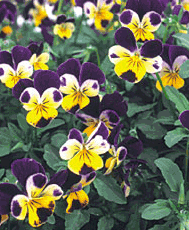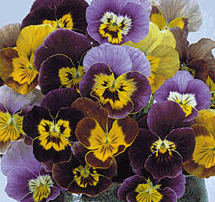
Love Pansies?
How to grow your own flowers from seed
By Marion Owen, Fearless Weeder for PlanTea, Inc. and
Co-author of Chicken Soup for the Gardener's Soul
FEATURE ARTICLE:

Tom Hanks' "Power of Four" solution
More good stuff:
Who is Marion Owen?
FAQs about PlanTea
Search Marion's articles, tips and recipes
Why grow organic?
News and press releases
Read love letters
How to link to this site
Need a speaker?
How to contact Marion
Visiting Alaska?
Come to Kodiak Island!
Go to home page

Marion's UpBeet Gardener
Newsletter has been
replaced by Marion's blog
which you can find at:
www.marionowen.wordpress.com
 I know a lot of things, but I'm an expert at nothing. In spite of my shortcomings, I try to answer questions whenever I can. Like this one from pansy lover, Angie Parker...
I know a lot of things, but I'm an expert at nothing. In spite of my shortcomings, I try to answer questions whenever I can. Like this one from pansy lover, Angie Parker...
Dear Marion,
Where are the seeds on a pansy plant? I have had great success with your hints on your site before, therefore, I would like to start growing pansies, using my own seeds. Any insights will be appreciated. Thank you for providing tips that makes gardening simple. -- Angie Parker
Hi Angie,
Your question is a good one, and one that straddles several topics. As one of the first plants to be set out in the spring, and one of the last to finish blooming in the fall, it's no wonder pansies are so popular. In her book, Bedding Plant Favorites, Lois Hole is a pansy cheerleader: "Pansies are hardy plants that bloom in almost  every colour except green."
every colour except green."
Because they are so easy to grow, pansies are also a good choice for children's gardens. "Young gardeners love the bright, friendly faces of the flowers," Lois adds.
As your basic plant though, pansies can be a tad confusing. A member of the viola family, they're listed as an annual, perennial or biennial, depending on who you talk to or which book you read. For example, Nancy Bubel, in her book, The New Seed-Starters Handbook, refers to violas as "technically a hardy biennial." Violas -- as in the classic Johnny-Jump-Ups (scroll up to the photo of the purple and yellow flowers at the top) -- are the traditional violas, originating in Spain and the Pyrenees Mountains. They self-seed freely (they toss their seeds as if feeding chickens) and come back each year.
But you don't have to get spun up around that stuff. The bottom line is, other than Johnny-Jump-Ups, the majority of pansies -- in seed racks, catalogs, or bedding plants in garden centers -- are hybrids. According to Seed Savers Exchange (SSE) none of the original pansies introduced in the 1800s by the Vilmorin Co. of Paris  still exist by their true names, though SSE does carry a selection closely resembling varieties grown 150 years ago, as seen in the photo at right.
still exist by their true names, though SSE does carry a selection closely resembling varieties grown 150 years ago, as seen in the photo at right.
This little bit of history is important to remember if you want to save your own seed and start your own pansies -- or any flower for that matter.
First, some basic biology: A hybrid is a new plant produced from cross-pollinating parent plants that are genetically different to make a new plant. In a seed catalog or seed packet you may see the something like "viola x wittrockiana" which designates a cross between the two parents; or say, F-1 which means the seeds or plant is the result of the first generation or first cross-pollination. Please note: Hybridizing or cross-pollination is NOT the same as being genetically modified or manipulated. Cross-pollination of plants happens all the time in nature, thanks to bees.
So, back to where the seeds are located on the plant. Those tiny, tiny seeds you seek are contained in the light brown, kidney bean-shaped pods, left after the flower withers. If you want to prolong the blooming period, you'd pinch off the faded blooms and seed pods; but seed collectors let the green seed pod mature until it becomes dry and papery thin -- a good time to collect seeds before they fall to the ground.
 Here's the deal, if you are collecting seeds from a hybrid plant, you will not get plants that "breed true" that is, they won't look anything like the plant from which you collected the seed. The new plants may or may not resemble one of both of the parents. You've heard people say, "Oh, she has your dad's eyes and your mom's nose." Same stuff.
Here's the deal, if you are collecting seeds from a hybrid plant, you will not get plants that "breed true" that is, they won't look anything like the plant from which you collected the seed. The new plants may or may not resemble one of both of the parents. You've heard people say, "Oh, she has your dad's eyes and your mom's nose." Same stuff.
My suggestion to you is to stick with the violas, or the old strains from Seeds Savers Exchange and develop your own pansies. It's a lot of fun!
Of course, Angie, this may have been way more information than you wanted, but I never promised you a SHORT answer!
Cheers to you and happy growing! -- Marion
![]()
Thanks for visiting and please stop by again. I'll put the coffee on!
Meet Marion Owen /// Learn about PlanTea /// Online Catalog /// Articles, Tips, Recipes /// Get free UpBeet Gardener newsletter /// Read current issue /// Listen to radio show /// Read news and press releases /// More resources and links /// Learn why 'grow organic?' /// View guidelines for retailers /// Read love letters /// Book Marion as a speaker /// Site map /// How to link to us /// Contact us /// Go to home page
PlanTea: The organic plant food in tea bags. http://www.plantea.com
Copyright ©1996 to present: PlanTea, Inc. All Rights Reserved. PO Box 1980, Kodiak, AK 99615-1980 USA
Questions or comments? marion@plantea.com Phone: Toll Free: 1-800-253-6331 (US and Canada); 907-486-2500